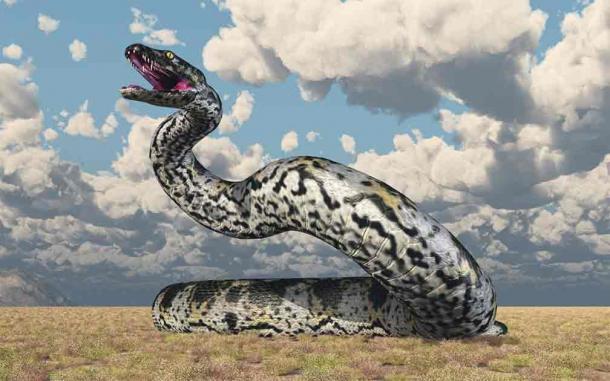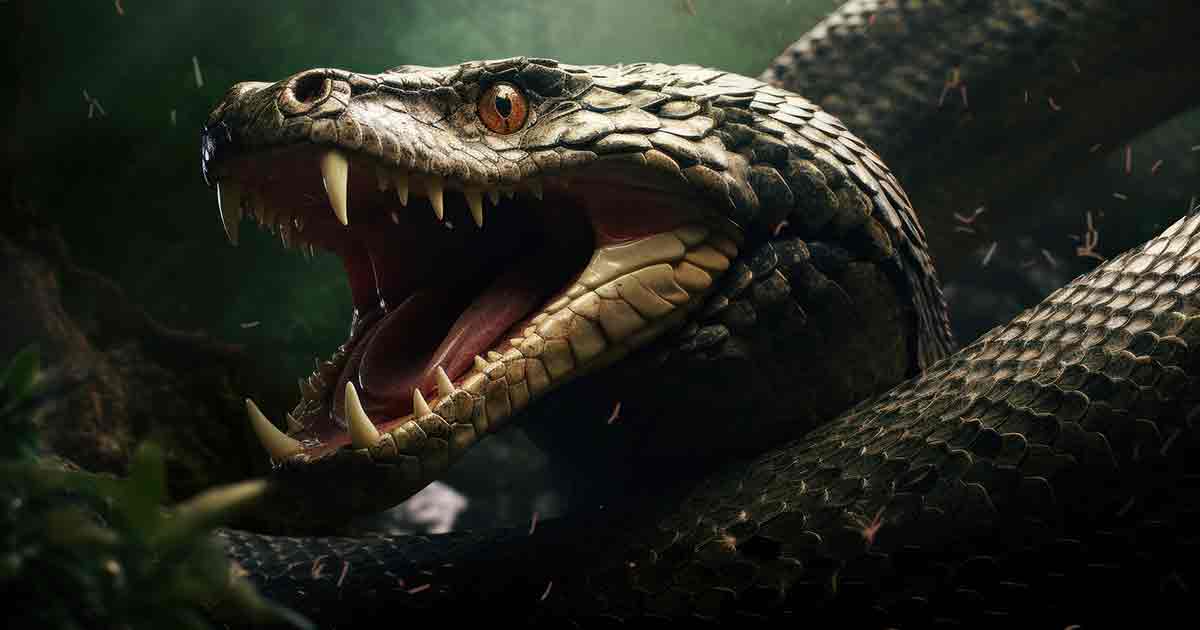Titanoboa: The Monster Snake that Ruled Prehistoric Colombia
You may not want to read about this frightening creature if you suffer from ophidiophobia, or even if you are about to embark on a camping trip. Once the largest snake in the world, Titanoboa fossils discovered in Colombia reveal that it lived during the Paleocene epoch about 60 million years ago. Even though you’re safe from its bone-crushing grip today, the thought of the huge prehistoric snake slithering around South America is still a terrifying one.
So far, the South American nation of Colombia has the only known fossils of the huge serpent. It is through these scant remains that paleontologists were able to estimate the size of this prehistoric creature. This estimation was then used to create a life-size model of Titanoboa, which was exhibited in 2012 in New York City’s Grand Central Terminal as a promotion for the Smithsonian Channel documentary entitled Titanoboa: Monster Snake.

Artistic representation of Titanoboa. (Michael Rosskothen / Adobe Stock)
Titanoboa: The Titanic Boa of Antiquity
Titanoboa, meaning “gigantic snake,” perfectly suits this ancient serpent's colossal proportions. Known to have existed during the Paleocene, tens of millions of years after the extinction event that wiped out the non-avian dinosaurs about 66 million years ago, it represents a fascinating chapter in the evolution of Earth's fauna.
Paleontologists estimate that Titanoboa could have reached lengths ranging between 42 and 49 feet (approximately 12.8 to 14.9 m)—as long as a school bus!—and weighed an astonishing 2500 pounds (1134 kg). Additionally, the thickest part of the snake's body is estimated to have had a diameter of 3 feet (approximately 0.9 meters).
- Before the Era of Dinosaurs, There Was a Ten-Legged Octopus
- The Giant Anaconda: Is There a Monster in the Amazon?
By comparison, the anaconda, one of today's largest snakes, can exceed 20 feet (6.1 m) in length and weigh over 500 pounds (227 kg). Titanoboa was clearly a giant compared to the largest snakes of modern times. But it wasn’t the only giant snake in the world. A few million years later, about 40 to 38 million years ago, Gigantophis existed in what is now North Africa, reaching lengths of around 33 feet (about 10 m).
There is a scientific explanation for the colossal size of the Titanoboa. Warmer temperatures during the Paleocene epoch would have provided favorable conditions for reptilian growth and development.
Reptiles are ectothermic, meaning they rely on external sources of heat to regulate their body temperature. Warmer climates would have allowed reptiles to metabolize food more efficiently, facilitating rapid growth and potentially leading to larger body sizes. Additionally, warmer temperatures may have extended the reptiles' active periods, allowing for increased foraging and feeding opportunities, which could contribute to their overall size.
While today’s anacondas are semiaquatic creatures able to hold their breath underwater for as long as 45 minutes, Titanoboa is believed to have been a land-dwelling snake, similar to modern-day boas. While it may have lived near water sources, such as rivers and swamps, it likely hunted and roamed primarily on land.
Scientists believe that TItanoboa was a formidable predator. But rather than relying on its venomous poison, this colossal constrictor—reminiscent of modern-day anacondas—wielded immense strength to squeeze the life from its victims. These would have included giant turtles and crocodiles. The idea is enough to send chills down your spine.

The Cerrejón coal mine in La Guajira, Colombia. An area known for its significant coal reserves, Cerrejón mine is one of the largest open-pit coal mines in the world and is the location where the Titanoboa fossils were discovered. (camaralucida1 / Adobe Stock)
Discovering Titanoboa: Delving into the Ancient Secrets of Colombia
The discovery of Titanoboa was made during the first decade of the 21st century in Cerrejón, a coal mine in the northern part of Colombia. In 2009 it was named Titanoboa cerrejonensis, meaning “the Titanoboa from Cerrejón.”
Nevertheless, the campaign that led to the discovery began in 1994, when the Colombian geologist Henry Garcia found an unfamiliar fossil which he labelled a “petrified branch” before placing it in one of the coal company’s display cases.
When a Colombian undergraduate geology student by the name of Fabiany Herrera was at Cerrejón for a field trip in 2003 he discovered fossilized plant remains. As the area had not been explored previously by paleontologists, an expedition was soon organized. One of the researchers invited to join the expedition was Scott Wing, the curator of fossil plants at the Smithsonian’s National Museum of Natural History.

Jeff Gage / Florida Museum
It was Wing who realized that Garcia’s fossil was not from a plant. He sent photos of it to another expert, the University of Florida paleontologist Jonathan Bloch, who identified the fossil as belonging to the jawbone of a land animal.
This was exciting news, as fossils of terrestrial vertebrates from the Paleocene epoch had not been found in that part of South America before. Researchers hypothesized that more fossils of such animals were to be found at the site, which proved to be true. Their preservation owes much to the swampy waters they inhabited, which facilitated the exceptional fossilization process.

Giant Titanoboa serpent confronting a prehistoric crocodile. (Daniel Eskridge / Adobe Stock)
Identifying the Titanoboa Monster Snake
It wasn't until 2007 that Titanoboa's vertebrae were identified during an inspection of a shipment marked “crocodile.” This discovery prompted fresh expeditions in search of more vertebrae. Eventually, paleontologists collected 100 snake vertebrae from 28 individuals, enabling them to estimate the size of the prehistoric snake.
In 2012, another important discovery about the Titanoboa was made when paleontologists unearthed a snake skull. Such a find is extremely rare, as snake skulls are very fragile and usually fall apart after the animal dies.
- Mythological Sea Serpents And Lake Monsters Versus Scientific Sharks And Surviving Dinosaurs
- Dinosaur-Eating Galloping Crocodiles Once Existed in the Sahara Desert
One of the peculiarities of this skull is that it has closely packed teeth, even more than modern day boas. This has led experts to speculate that Titanoboa was a specialized fish-eater. Still, considering its size, Titanoboa could have easily preyed on prehistoric turtles and crocodiles, which lived in the same habitat as this snake.

Replica Titanoboa created by Kevin Hockley. (Kelly Verdeck / CC BY-ND 2.0 DEED)
These later discoveries prompted the 2012 creation of a life-size model of Titanoboa exhibited in New York City’s Grand Central Terminal to promote the Smithsonian Titanoboa documentary. Created by Kevin Hockley of Hockley Studios, a sculptor and model maker with a vast portfolio, the 48-foot replica Titanoboa was represented chomping down on a dyrosaur (a kind of ancient crocodile)
While indigenous Amazonian folklore has incorporated takes of giant serpent-like creatures swelling in its rivers and waterway, such as the Yacumama, Boitatá and Cobra Grande, Titanoboa is known only from fossil records, and there is no indication that any similar species exist in the present-day Amazon ecosystem. Nevertheless, some believe that Titanoboas still survive deep in the Amazon.
Top image: Representational image of a prehistoric Titanoboa. Source: anis rohayati / Adobe Stock
By Wu Mingren
References
Gugliotta, G. April 2012. “How Titanoboa, the 40-Foot-Long Snake, Was Found” in Smithsonian Magazine. Available at: https://www.smithsonianmag.com/science-nature/how-titanoboa-the-40-foot-long-snake-was-found-115791429/
Keen, C. 1 April 2009. “At 45 feet long, ´Titanoboa´snake ruled the Amazon” in Florida Museum. Available at: https://www.floridamuseum.ufl.edu/science/at-45-feet-long-titanoboa-snake-ruled-the-amazon/
Kelley, 11 January 2024. “Titanoboa: The World’s Largest Snake Ever” in Owlcation. Available at: https://owlcation.com/stem/Titanoboa-The-Worlds-Largest-Snake-Ever
Polly, P. D. 25 February 2024. “Titanoboa” in Britannica. Available at: https://www.britannica.com/animal/Titanoboa
Simon, M. 23 May 2014. “Absurd Creature of the Week: The 2,500-Pound Snake That Devoured Gigantic Crocodiles” in Wired. Available at: https://www.wired.com/2014/05/absurd-creature-of-the-week-the-2500-pound-snake-that-devoured-gigantic-crocodiles/
Smithsonian Insider. 6 March 2012. “Largest snake the world has ever seen is being brought back to life by Smithsonian Channel” in Smithsonian. Available at: https://www.si.edu/stories/largest-snake-world-has-ever-seen-being-brought-back-life
Smithsonian Institution, No date. “Titanoboa: Monster Snake” in Smithsonian. Available at: https://www.sites.si.edu/s/archived-exhibit?topicId=0TO36000000L5NmGAK
Strauss, B. 15 July 2017. “The 50-Foot-Long, 2,000-Pound Giant Prehistoric Snake, Titanoboa” in ThoughtCo. Available at: https://www.thoughtco.com/titanoboa-worlds-biggest-prehistoric-snake-1093334




















Comments
Hi All,
Hope the New Year has started off Great for everyone.
This is exciting news I first saw the Smithsonian Documentary on Ytube. I remember thinking when first learning about Titanoboa (I bet this was the snake who talked to Eve); getting back to Titanoboa, I know that Paleontologist believe that these Snakes only lived in Columbia; but since, other places in South America have yet to be explored should the declaration be empathic?
I remember seeing the documentary on Surveyor from either England or Scotland his name was Plessy Fawcett, I believe but, this Plessy was tight buddies with Sir Arthur Conan Doyle in fact it was Plessy who inspired Doyle to write the adventure Book The Lost World.
As I recall Plessy was assigned to South America in Brazil to conduct some kind of Surveying Project, this Plessy Fawcett Person was said to be The most meticulous researcher and Note taker for Britain as a Surveyor; even so when he brought back news of seeing creatures, still thriving within The Jungles of Brazil that were considered long since to be extinct he was met quite naturally with skepticism.
One of the animal's Plessy had seen was that of a Snake which measured a whopping 60 feet long Plessy that the Snake itself was an Anaconda but, if it wasn't an seconds Plessy had seen he might have actually been looking at a Living Titanoboa which means perhaps Titanoboa grew even longer than the Anaconda.
Plessy left behind his notes with Britain and in the care of his friend Arthur Doyle; from his first Surveying job in Brazil but, since no one believed him he decided to go back and get the evidence of what he'd seen but, before he left England Plessy instructed England if they don't hear from him, Do Not Send any Rescuers after Him.
Plessy was never heard from again when going off on this second exploration oddly his Son came with Him and was never heard from either.
The notes and writing that Plessy left behind is the bases of Sir Arthur Conan Doyle's The Lost World; much of the story came pretty much from Plessy's own notes.
The only thing Doyle added to the mix were three more people.
It was the size of the snake that stood out to me in Plessy's testimony of a 60 foot long Snake.
Columbia is certainly a hot spot to keep exploring but, I do think paleontologist should consider expeditions in pursuit of snake fossils in other places in South America, Brazil, Venezuela, Chile, Bolivia, and a host of other places.
All in all this was in fact a great article to read and discuss so thank you for the info from the writer of this article on Titanoboa: The Monster Snake that ruled Pre-History Columbia.
I'll take my leave for now so until next time; Everyone, Goodbye!